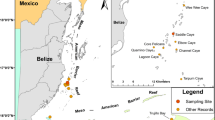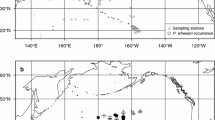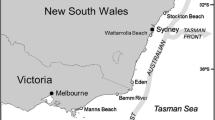Abstract
Our basic knowledge of the ecology, especially the age and growth of polar deep-sea biota is still scarce. This study provides first data about the age and growth of the two abundant Arctic fish species Lycodes frigidus and Lycodes squamiventer (Zoarcidae). Lycodes frigidus was caught at the deeper parts (1,546–3,576 m depth) of the HAUSGARTEN observatory (HG), west of Svalbard. The congener Lycodes squamiventer was caught at two HG stations (1,273–1,546 m) and at the Håkon Mosby Mud Volcano (HMMV, ~1,250 m), a cold seep in the southwestern Barents Sea. Age was determined by sagittal otolith increment analysis. Growth performance was assessed by fitting age–length data to a von Bertalanffy growth equation. Our data suggest that L. frigidus and L. squamiventer attain maximum ages of 33 and 21 years, respectively. Lycodes squamiventer from the HMMV had significantly higher growth rates and their maximum age and length was slightly lower compared to conspecifics from the shallow HG stations. Von Bertalanffy growth equations were L t = 58.9 ∗ (1 − e(−0.042*t)) for L. frigidus, and L t = 25.3 ∗ (1 − e(−0.074*t)) and L t = 24.2 ∗ (1 − e(−0.099 * t)) for L. squamiventer from HG and the HMMV, respectively. A comparison of these data with those of eight other zoarcids indicates that growth performances are correlated with temperature: the higher the annual mean temperatures experienced, the higher the growth rates. However, maximum ages decrease with increasing temperatures.






Similar content being viewed by others
References
Albrechtsen K (1968) A dyeing technique for otolith age reading. J Cons Perm Int Explor Mer 32:278–280
Anderson ME (1984) Zoarcidae: development and relationships. In Ontogeny and systematics of fishes. Am Soc Ichthyol Herpetol Spec Publ 1:579–582
Anderson ME, Fedorov VV (2004) Annotated checklist of fishes: family Zoarcidae Swainson 1839—eelpouts. Calif Acad Sci 34:1–58
Andriyashev AP (1986) Zoarcidae. In: Whitehead PJP, Bauchot M-L, Hureau JC, Nielsen J, Tortonese E (eds) Fishes of the north-eastern Atlantic and the Mediterranean, vol III. The Chaucer Press, Bungay, pp 1130–1150
Balanov AA, Badaev OZ, Napazakov VV, Chuchukalo VI (2006) Distribution and some biological features of Lycodes raridens (Zoarcidae) in the western part of the Bering Sea. J Ichthyol 46:148–155
Becker GA, Schulz A (2000) Atlas of North Sea surface temperatures. Weekly and monthly means for the period 1969–1993. Dtsch Hydrogr Zeitschr Suppl 11:1–79
Bergmann M, Dannheim J, Bauerfeind E, Klages M (2009) Trophic relationships along a bathymetric gradient at the deep-sea observatory HAUSGARTEN. Deep-Sea Res I 56:408–424
Bergmann M, Soltwedel T, Klages M (2011) The interannual variability of megafaunal assemblages in the Arctic deep sea: preliminary results from the HAUSGARTEN observatory (79ºN). Deep-Sea Res I (in press)
Beverton RJH, Holt SJ (1957) On the dynamics of exploited fish populations. Fish. Investig. Ser. II vol XIX. Fisheries Laboratory, Lowestoft, pp 533
Bjelland O, Bergstad OA, Skjæraasen JE, Meland K (2000) Trophic ecology of deep-water fishes associated with the continental slope of the eastern Norwegian Sea. Sarsia 85:101–117
Brodte E (2001) Wachstum und Fruchtbarkeit der Aalmutterarten Zoarces viviparus (Linné) und Pachycara brachycephalum (Pappenheim) aus unterschiedlichen klimatischen Regionen. Diploma thesis, University of Bremen, pp 86
Brodte E, Knust R, Pörtner HO, Arntz WE (2006) Biology of the Antarctic eelpout Pachycara brachycephalum. Deep-Sea Res II 53:1131–1140
Budaeva NE, Mokievsky VO, Soltwedel T, Gebruk AV (2008) Horizontal distribution patterns in Arctic deep-sea macrobenthic communities. Deep-Sea Res I 55:1167–1178
Byrkjedal I, Høines Å (2007) Distribution of demersal fish in the south-western Barents Sea. Polar Res 26:135–151
Campbell NA, Reece JB (2003) Biologie, 6. Auflage. Auflage. Spektrum Akademischer Verlag, Heidelberg
Clarke A (1983) Life in cold water: the physiological ecology of polar marine ectotherms. Oceanogr Mar Biol 21:341–453
Clarke A, Johnston NM (1999) Scaling of metabolic rate with body mass and temperature in teleost fish. J Anim Ecol 68:893–905
Clarke A, North AW (1991) Is the growth of polar fish limited by temperature? In: Di Prisco G, Maresca B, Tota B (eds) Biology of Antarctic fishes. Springer, Berlin, pp 54–69
Coad B, Waszczuk H, Labignan I (1995) Encyclopedia of Canadian fishes. Canadian Museum of Nature and Canadian Sportfishing Production, Waterdown
Ekau W (1988) Ökomorphologie nototheniider Fische aus dem Weddellmeer, Antarktis. Rep Polar Mar Res 51:1–140
Gebruk AV, Krylova EM, Lein AY, Vinogradov GM, Anderson E, Pimenov NV, Cherkashev GA, Crane K (2003) Methane seep community of the Håkon Mosby Mud Volcano (the Norwegian Sea): composition and trophic aspects. Sarsia 88:394–403
Gotthard K (2000) Increased risk of predation as a cost of high growth rate: an experimental test in the speckled wood butterfly, Pararge aegeria. J Anim Ecol 69:896–902
Jerosch K, Schlüter M, Foucher J-P, Allais A-G, Klages M, Edy C (2007) Spatial distribution of mud flows, chemoautotrophic communities, and biogeochemical habitats at Håkon Mosby Mud Volcano. Mar Geol 243:1–17
Jobling M (2002) Environmental factors and rates of development and growth. In: Hart PJB, Reynolds JD (eds) Handbook of fish biology and fisheries, Volume 1: fish biology. Blackwell Publishing, Malden, pp 97–122
Kappenman RF (1981) A method for growth curve comparisons. Fish Bull 79:95–101
Kaul N, Foucher J-P, Heesemann M (2006) Estimating mud expulsion rates from temperature measurements on Håkon Mosby Mud Volcano, SW Barents Sea. Mar Geol 229:1–14
Klages M, Boetius A, Christensen JP, Deubel H, Piepenburg D, Schewe I, Soltwedel T (2003) The benthos of Arctic Seas and its role for the carbon cycle at the seafloor. In: Stein R, Macdonald RW (eds) The Arctic organic carbon cycle. Springer, Heidelberg, pp 139–167
Kock K-H, Duhamel G, Hureau J-C (1985) Biology and status of exploited Antarctic fish stocks: a review. BIOMASS Sci Ser 6:1–143
La Mesa M, Vacchi M (2001) Age and growth of high Antarctic notothenioid fish. Antarct Sci 13:227–235
Lalli CM, Parsons TR (1997) Biological oceanography: an introduction, 2nd edn. Elsevier Butterworth-Heinemann, Oxford
Levings CD (1969) The zoarcid Lycodopsis pacifica in outer Burrard Inlet, British Columbia. J Fish Res Board Can 26:2403–2412
Matallanas J (2011) Description of two new species of Ophthalmolycus (Teleostei: Zoarcidae) from the Southern Ocean and key to species of the genus. J Mar Biol Assoc UK 91(2):561–567
McAllister DE, Anderson ME, Hunter JG (1981) Deep-water eelpouts, Zoarcidae, from Arctic Canada and Alaska. Can J Fish Aquat Sci 28:821–839
Mecklenburg CW, Møller PR, Steinke D (2010) Biodiversity of Arctic marine fishes: taxonomy and zoogeography. Mar Biodivers. doi:10.1007/s12526-010-0070-z
Metcalfe NB, Monaghan P (2001) Compensation for a bad start: grow now, pay later? Trends Ecol Evol 16:254–260
Metcalfe NB, Monaghan P (2003) Growth versus life span: perspectives from evolutionary ecology. Exp Gerontol 38:935–940
Milkov A, Vogt P, Cherkashev G, Ginsburg G, Chernova N, Andriashev A (1999) Sea-floor terrains of Håkon Mosby Mud Volcano as surveyed by deep-tow video and still photography. Geo-Mar Lett 19:38–47
Milkov AV, Vogt PR, Crane K, Lein AY, Sassen R, Cherkashev GA (2004) Geological, geochemical, and microbial processes at the hydrate-bearing Håkon Mosby Mud Volcano: a review. Chem Geol 205:347–366
Møller PR (2001) Redescription of the Lycodes pallidus species complex (Pisces, Zoarcidae), with a new species from the Arctic/North Atlantic Ocean. Copeia 2001(4):972–996
Møller PR, Gravlund P (2003) Phylogeny of the eelpout genus Lycodes (Pisces, Zoarcidae) as inferred from mitochondrial cytochrome b and 12S rDNA. Mol Phylogenetics Evol 26:369–388
Møller PR, Nielsen JG, Anderson ME (2005) Systematics of polar fishes. Fish Physiol 22:25–78
Nash RDM (1986) Aspects of the general biology of Vahl’s eelpout, Lycodes vahlii gracilis M. Sars, 1867 (Pisces, Zoarcidae), in Oslofjorden, Norway. Sarsia 71:289–296
Nelson JS (2006) Fishes of the world, 4th edn. Wiley, Hoboken, p 624
Niemann H, Lösekann T, de Beer D, Elvert M, Nadalig T, Knittel K, Amann R, Sauter EJ, Schlüter M, Klages M, Foucher JP, Boetius A (2006) Novel microbial communities of the Haakon Mosby mud volcano and their role as a methane sink. Nat 443:854–858
Pauly D (1980) On the interrelationships between natural mortality, growth parameters, and mean environmental temperature in 175 fish stocks. J Cons Int Explor Mer 39:175–192
Pimenov N, Savvichev A, Rusanov I, Lein A, Ivanov M (2000) Microbiological processes of the carbon and sulfur cycles at cold methane seeps of the North Atlantic. Microbiol 69:709–720
Pitcher TJ, Hart PJB (1982) Fisheries Ecol. Croom Helm, London
Pörtner HO, Berdal B, Blust R, Brix O, Colosimo A, De Wachter B, Giuliani A, Johansen T, Fischer T, Knust R, Lannig G, Naevdal G, Nedenes A, Nyhammer G, Sartoris FJ, Serendero I, Sirabella P, Thorkildsen S, Zakhartsev M (2001) Climate induced temperature effects on growth performance, fecundity and recruitment in marine fish: developing a hypothesis for cause and effect relationships in Atlantic cod (Gadus morhua) and common eelpout (Zoarces viviparus). Cont Shelf Res 21:1975–1997
Prouse NJ, McAllister DE (1986) The Glacial Eelpout, Lycodes frigidus, from the Arctic Canadian Basin, new to the Canadian ichthyofauna. Can Field-Nat 100:325–329
Schauer U, Beszczynska-Möller A, Walczowski W, Fahrbach E, Piechura J, Hansen E (2008) Variation of measured heat flow through the Fram Strait between 1997 and 2006. In: Dickson RR, Meincke J, Rhines P (eds) Arctic-Subarctic Ocean Fluxes. Springer Science + Business Media B.V., pp 65–85
Schlichtholz P, Houssais M-N (2002) An overview of the θ−S correlations in Fram Strait based on the MIZEX 84 data. Oceanol 44:243–272
Soltwedel T, Bauerfeind E, Bergmann M, Budaeva N, Hoste E, Jaeckisch N, von Juterzenka K, Matthiessen J, Mokievsky V, Nöthig E-M, Quéric N-V, Sablotny B, Sauter E, Schewe I, Urban-Malinga B, Wegner J, Wlodarska-Kowalczuk M, Klages M (2005) HAUSGARTEN: multidisciplinary investigations at a deep-sea, long-term observatory in the Arctic Ocean. Oceanogr 18:46–61
Soltwedel T, Jaeckisch N, Ritter N, Hasemann C, Bergmann M, Klages M (2009) Bathymetric patterns of megafaunal assemblages from the arctic deep-sea observatory HAUSGARTEN. Deep-Sea Res I 56:1856–1872
Stefansdottir L, Solmundsson J, Marteinsdottir G, Kristinsson K, Jonasson JP (2010) Groundfish species diversity and assemblage structure in Icelandic waters during recent years of warming. Fish Oceanogr 19(1):42–62
Taylor CC (1958) A note on Lee’s phenomenon in Georges Bank haddock. ICNAF Spec Publ 1:243–251
Tokranov AM, Orlov AM (2002) Distribution and some features of the biology of eelpouts Lycodes brunneofasciatus and L. albolineatus (Zoarcidae) in the Pacific waters off the northern Kuril Islands and southeast Kamchatka. J Ichthyol 42:579–590
Vinogradova NG, Turpaeva EP, Moskalev LI, Galkin SV, Bagirov NE (1996) Species composition of the bottom fauna in the area of study, leading and common forms and modifications of communities. In: Vinogradov ME, Sagalevitch AM, Khetagurov SV (eds) Oceanographic research and underwater technical operations at the site of the nuclear submarine Komsomolets wreck. Nauka, Moscow, pp 202–206 (in Russian)
Vogt PR, Cherkashev G, Ginsburg G, Ivanov G, Milkov A, Crane K, Lein A, Sundvor E, Pimenov N, Egorov A (1997) Haakon Mosby Mud Volcano provides unusual example of venting. EOS Transact Am Geophys Union 78(48):549 556–557
Von Dorrien CF (1993) Ökologie und Respiration ausgewählter arktischer Bodenfischarten. Rep Polar Mar Res 125:1–99
Wakeling JM, Johnston IA (1998) Muscle power output limits fast-start performance in fish. J Exp Biol 201:1505–1526
Włodarska-Kowalczuk M, Kendall MA, Węsławski JM, Klages M, Soltwedel T (2004) Depth gradients of benthic standing stock and diversity on the continental margin at a high-latitude ice-free site (off Spitsbergen, 79°N). Deep-Sea Res I 51:1903–1914
Wright PJ, Panfili J, Morales-Nin B, Geffen AJ (2002) Types of calcified structures—otoliths. In: Panfili J, de Pontual H, Troadec H, Wright PJ (eds) Manual of fish sclerochronology. Ifremer-IRD coedition, Brest, pp 31–57
Acknowledgments
We thank the officers and crews of RVs Polarstern and L’Atalante and the teams of the remotely operated vehicles "Victor 6000" and "Quest 4000" for their support. J. Wegner, B. Sablotny and N. Koschnick gave technical support during lander deployments. E. Brodte gave instructions on the preparation of the otoliths, their reading and provided age estimates. M. Volkenandt and A. Pappert assisted in the sanding of otoliths. We are indebted to Peter Rask Møller, David Bailey and an anonymous reviewer for improvements to an earlier draft of the manuscript. This paper is based on Nicole Hildebrandt’s diploma thesis (Carl von Ossietzky Universität Oldenburg) and is publication no. awi-n19293 of the Alfred Wegener Institute for Polar and Marine Research.
Conflict of interest
The authors declare that they have no conflict of interest.
Author information
Authors and Affiliations
Corresponding author
Rights and permissions
About this article
Cite this article
Hildebrandt, N., Bergmann, M. & Knust, R. Longevity and growth efficiency of two deep-dwelling Arctic zoarcids and comparison with eight other zoarcid species from different climatic regions. Polar Biol 34, 1523–1533 (2011). https://doi.org/10.1007/s00300-011-1011-4
Received:
Revised:
Accepted:
Published:
Issue Date:
DOI: https://doi.org/10.1007/s00300-011-1011-4




